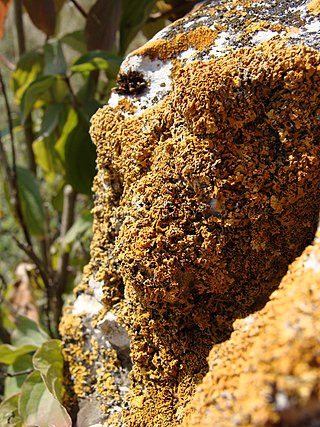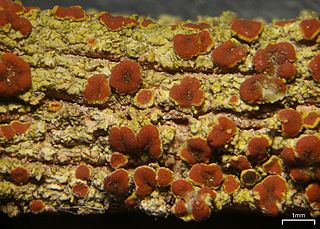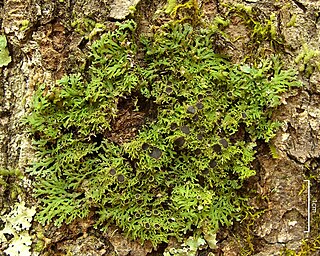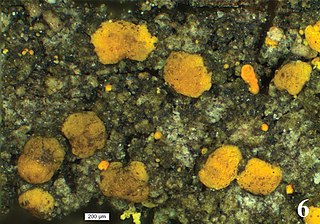
The Physciaceae are a family of mostly lichen-forming fungi belonging to the class Lecanoromycetes in the division Ascomycota. A 2016 estimate placed 19 genera and 601 species in the family.
Agonimia is a genus of lichen-forming fungi in the family Verrucariaceae.

Candelariaceae is a family of lichen-forming fungi in the order Candelariales. It contains seven genera and about 73 species.
Neobrownliella brownlieae is a species of saxicolous (rock-dwelling), crustose lichen in the family Teloschistaceae. It is widely distributed in Australia.

Flavoplaca is a genus of crust-like or scaly lichens in the family Teloschistaceae. It has 28 species with a mostly Northern Hemisphere distribution.
Filsoniana is a genus of squamulose lichens in the family Teloschistaceae. It has six species. It was circumscribed in 2013 by Ingvar Kärnefelt, Arne Thell, Jae-Seoun Hur, Sergey Kondratyuk, and John Elix following a molecular phylogenetic analysis of the Teloschistaceae. The generic name honours Australian lichenologist Rex Filson, "in recognition of his contribution to lichenology, in particular to the lichen flora of Australia".
Gallowayella aphrodites is a species of corticolous (bark-dwelling), foliose (leafy) lichen in the family Teloschistaceae. It is found in the Mediterranean countries Greece, Cyprus, and Italy. Characteristics of the lichen include its small thallus, the disposition of the rhizines on the thallus undersurface, and the lack of vegetative propagules.
Kashiwadia is a genus of lichen-forming fungi in the family Physciaceae. The genus was circumscribed in Sergey Kondratyuk, László Lőkös, and Jae-Seoun Hur in 2014 to contain the species Physcia orientalis, after molecular phylogenetic analysis showed that the taxon occupied an isolated phylogenetic position in the Physciaceae. An additional five species were added to the genus in 2021. The genus name honours Japanese lichenologist Hiroyuki Kashiwadani, who originally described the type species.
Candelaria asiatica is a lichenized species of fungus in the genus Candelaria, family Candelariaceae. Recognized by its small yellow lobate thallus, this species is found growing under open areas in forests. It is distributed in South Asia, Pakistan, and China.
Candelinella is a genus of lichen-forming fungi in the family Candelariaceae. It contains two species of crustose lichens. It is visually similar to the genus Candelina but has unique features, including a distinct thallus and unique spore structures. It was established by Sergey Kondratyuk in 2020, with Candelinella makarevichiae assigned as the type species. The genus is distinguished by the small, crustose thallus that ranges from a granular to areolate or squamulose texture, and the simple to 1-septate, narrowly ellipsoid to oblong ascospores. Its lack of a lower cortex and medulla further sets it apart from Candelina.
Opeltiella fibrosoides is a species of lichen-forming fungus in the family Candelariaceae. It is known to occur only in a single location in Peru, where lichen thrives in a high-altitude environment, specifically on shrubs and cacti in an open pasture land. It was formally described as a new species by Swedish lichenologists Martin Westberg and Patrik Frödén in 2007, first as a member of the genus Candelaria. Although it bears a striking resemblance to C. fibrosa on the surface, it is differentiated by its eight-spored asci and a thallus featuring an ecorticate lower surface. In 2020, Sergey Kondratyuk transferred the taxon to the newly circumscribed genus Opeltiella, following molecular phylogenetic-based analysis of the family Candelariaceae.
Teuvoahtiana is a genus of lichen-forming fungi in the family Teloschistaceae. It contains three species of saxicolous (rock-dwelling), crustose lichens, all of which occur in South America.

Zeroviella is a genus of lichen-forming fungi in the subfamily Xanthorioideae of the family Teloschistaceae. It has eight saxicolous (rock-dwelling) species. Zeroviella was segregated from Rusavskia, a closely related genus, in 2015.

Opeltia is a genus of lichen-forming fungi in the family Teloschistaceae. It has four species of corticolous (bark-dwelling), crustose lichens.

Erichansenia is a genus of lichen-forming fungi in the family Teloschistaceae. It has three species of saxicolous (rock-dwelling), crustose lichens.

Kurokawia is a genus of lichen-forming fungi in the family Physciaceae. It has seven species of foliose lichens. The genus, circumscribed in 2021, has Kurokawia isidiata as the type species.
Fauriea is a genus of lichen-forming fungi in the family Teloschistaceae. The genus, which contains seven species, is a member of the subfamily Caloplacoideae.
Hosseusiella is a genus of lichen-forming fungi in the family Teloschistaceae. It has three species of crustose to foliose (leafy) lichens, some of which grow on bark, while others grow on rock. All three occur in the southern part of the South American continent, where they are fairly common.

Protocandelariella is a genus of lichen-forming fungi in the family Candelariaceae. It has two species of squamulose (scaley), corticolous (bark-dwelling) lichens.
Pisutiella is a genus of lichen-forming fungi in the family Teloschistaceae. It contains five species of saxicolous (rock-dwelling), crustose lichens that are found in a variety of environments in the Northern Hemisphere.







